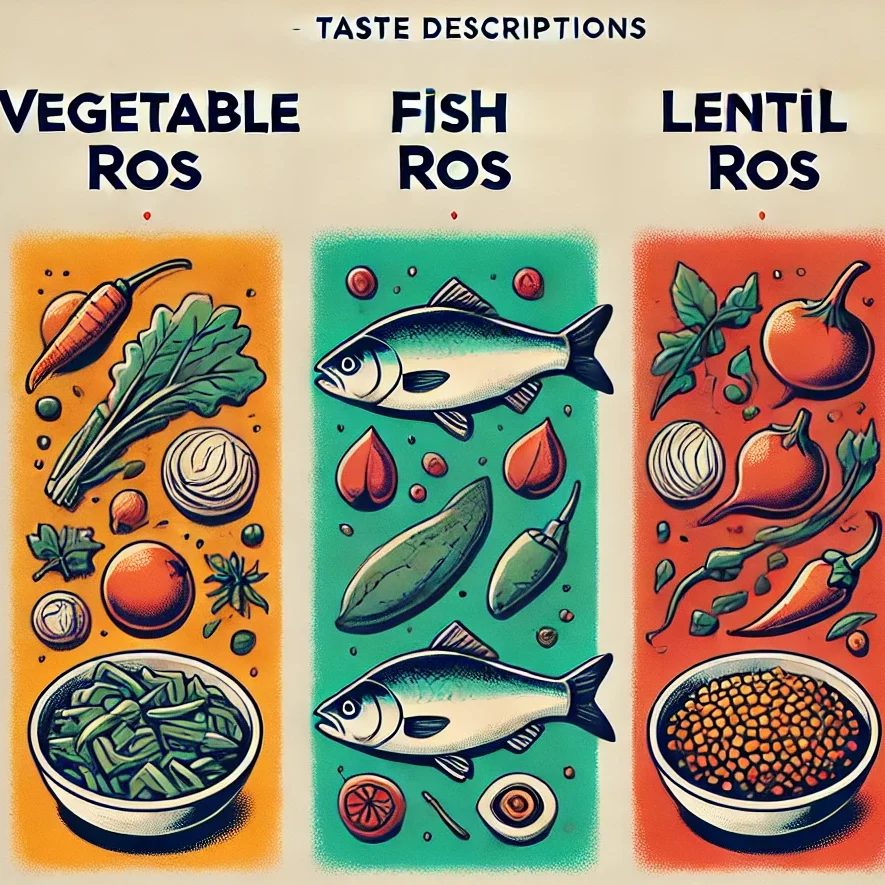In Goan cuisine, “Ros” (also spelled “Raas”) refers to a simple yet flavorful coconut-based curry, often made with fish or seafood. It is a staple in many Goan households, usually served with steamed rice. The term “ros” itself means “gravy” in Konkani.
History
Origins and Influences:
Pre-Portuguese Era:
Before the Portuguese colonization in the 16th century, the local cuisine was predominantly based on rice, coconut, fish, and vegetables. Coconut milk and grated coconut were essential components of curries and gravies. The use of local spices like tamarind and kokum added tanginess to the dishes.
Portuguese Influence:
The Portuguese introduced new ingredients like potatoes, tomatoes, and chilies to Goa. These ingredients were quickly integrated into the local cuisine, giving rise to more complex flavors. The use of red chilies and vinegar, seen in many Goan curries, can be attributed to this influence.
Cultural Integration:
Over centuries, the Hindu and Christian communities in Goa adapted ros recipes to suit their cultural and dietary preferences. While Hindu versions might avoid meat and emphasize vegetables and lentils, Christian variations often incorporate seafood, pork, and beef.
Culinary Significance:
Daily Meals: In many Goan households, ros is a staple dish, often prepared fresh every day. It serves as a comforting, hearty meal when paired with steamed rice.
Variety and Versatility:
There are many variations of ros, including prawn ros, fish ros, alsande ros (black-eyed pea curry), and vegetarian options. The versatility makes it an inclusive dish enjoyed across different communities.
Symbolism and Tradition:
Ros represents Goan hospitality and the spirit of sharing. It is a dish that binds families together, especially during lunch, the main meal of the day. In traditional Goan homes, the aroma of ros simmering on the stove evokes nostalgia and a sense of home.
Taste Description
The taste of Goan Ros is a harmonious blend of coconut richness, tangy tamarind, and warm spices. Each bite carries the creaminess of freshly ground coconut balanced by the slight heat from red chilies and the earthiness of coriander and cumin.The tanginess from tamarind or kokum adds a refreshing, mildly sour kick that contrasts beautifully with the sweet, nutty flavors of coconut. If seafood like prawns or fish is added, it brings a natural sweetness and a subtle brininess, enhancing the overall depth. Vegetarian versions have a comforting, earthy taste from ingredients like black-eyed peas or seasonal vegetables.The spices aren’t overwhelming; they create a gentle warmth that lingers on the palate, making it a comforting and satisfying dish. Paired with steamed rice or Goan poi (bread), it’s a burst of authentic coastal flavors—a perfect balance of savory, tangy, and mildly spicy notes.

Recipe
Ingredients:
1 cup grated fresh coconut
1 tbsp coriander seeds
2-3 dried red chilies
1/2 tsp cumin seeds
1/2 tsp turmeric powder
2 cloves garlic
A small piece of tamarind or 1 tbsp tamarind paste
1 medium onion, chopped
1 green chili, slit
Salt to taste
1 tbsp coconut oil
1 cup cooked lentils, vegetables, prawns, or fish (depending on preference)
Water for consistency
Instructions:
1. Make the Curry Paste:
In a blender, add grated coconut, coriander seeds, dried red chilies, cumin seeds, turmeric, garlic, and tamarind.Add a little water and grind into a smooth paste.
2. Prepare the Ros:
Heat coconut oil in a pan and sauté chopped onions and slit green chili until the onions turn translucent.Add the curry paste and cook for 2-3 minutes until aromatic.Add the cooked lentils, vegetables, prawns, or fish to the pan. Mix well.Add water to adjust the consistency and season with salt.Let it simmer for about 5-7 minutes, allowing the flavors to meld.
3. Serve:
Garnish with fresh coriander leaves.Serve hot with steamed rice or Goan bread (poi).
Variations:
Vegetarian: Use lentils or vegetables like pumpkin, okra, or potatoes.Seafood: Prawns or mackerel are popular choices.
Non-Vegetarian: Chicken or mutton can also be used for a richer version.

Nutritional Value
Goan Ros is a wholesome dish with a moderate calorie count, providing around 180-250 kcal per serving. It offers a balance of protein (5-8 g) and carbohydrates (20-30 g), making it satisfying and energizing. The dish has a moderate fat content (10-15 g), primarily from coconut, which contributes healthy fats. It is also a good source of fiber (4-6 g), aiding digestion. Depending on the ingredients used—such as seafood, lentils, or vegetables—it can be rich in vitamin C, B vitamins, iron, magnesium, and potassium. The sodium content ranges from 300-400 mg, so mindful seasoning is advised for those watching their salt intake. Overall, Goan Ros is a flavorful, nutritious dish that reflects the essence of coastal cuisine.
Personal Experience
From a Goan perspective, Ros is more than just a dish—it’s a comforting, flavorful part of everyday life. Growing up in a Goan household, the aroma of simmering coconut, spices, and tamarind would fill the kitchen, signaling that lunchtime was near. Each family has its own way of making Ros—some prefer it tangier, while others like it rich and creamy. The versatility of Ros allows it to be paired with fish, prawns, vegetables, or lentils, making it adaptable to various tastes and preferences. Eating Ros with hot, steamed rice or freshly baked Goan bread (poi) brings a sense of warmth and nostalgia. It’s a dish that embodies the essence of coastal living, the abundance of coconut trees, and the connection to the sea. For many Goans, Ros isn’t just food—it’s a cherished memory shared with family and friends.
